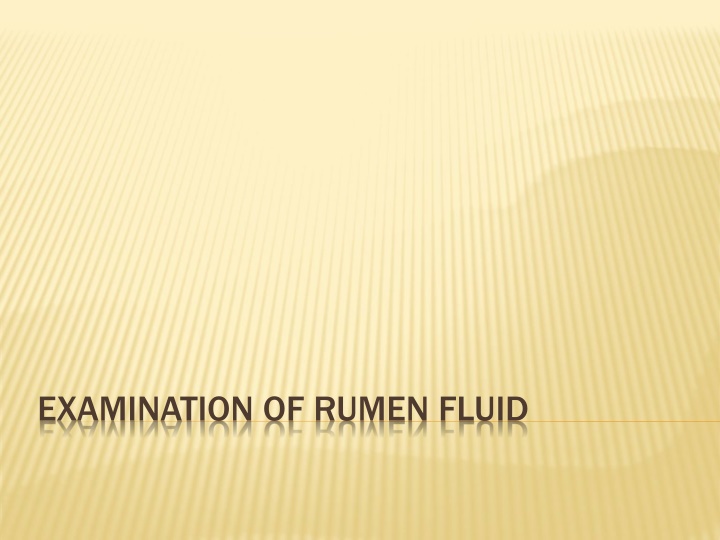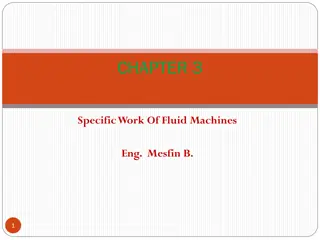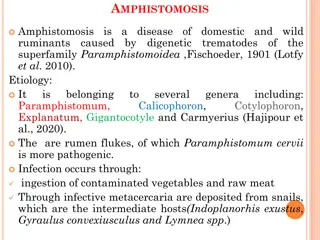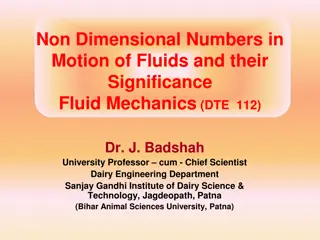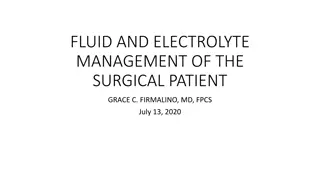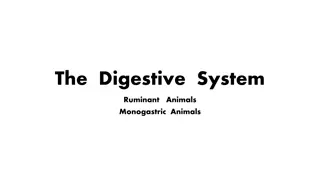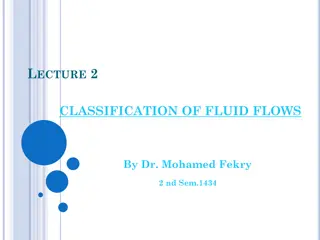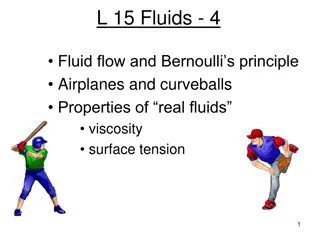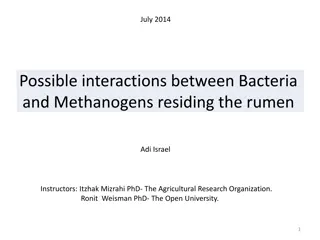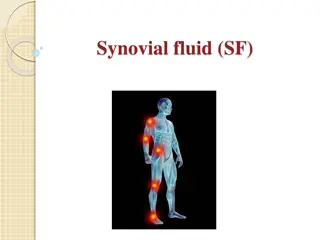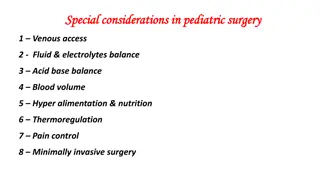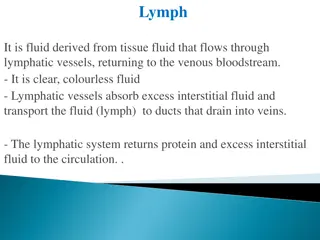Examination of Rumen Fluid and Methods of Collection
The examination of rumen fluid is crucial for diagnosing rumen diseases and for therapeutic purposes like transfaunation. Various physical and chemical characteristics are analyzed, including color, consistency, pH levels, and sedimentation activity. Abnormal findings indicate different health issues such as acidosis, indigestion, and bacterial imbalances. Methods of collecting rumen fluid include needle puncture or using a collection tube via the oral or nasal passage to avoid peritoneal contamination.
Download Presentation

Please find below an Image/Link to download the presentation.
The content on the website is provided AS IS for your information and personal use only. It may not be sold, licensed, or shared on other websites without obtaining consent from the author.If you encounter any issues during the download, it is possible that the publisher has removed the file from their server.
You are allowed to download the files provided on this website for personal or commercial use, subject to the condition that they are used lawfully. All files are the property of their respective owners.
The content on the website is provided AS IS for your information and personal use only. It may not be sold, licensed, or shared on other websites without obtaining consent from the author.
E N D
Presentation Transcript
EXAMINATION OF RUMEN FLUID Indications Indications 1. It is often essential to establish an accurate diagnosis of diseases of the rumen. 2. It is also essential when rumen fluid is collected for therapeutic transfaunation. (For treatment of acidosis, simple indigestion, rumen stasis, stop rumination and regurgitation).
METHODS OF COLLECTION METHODS OF COLLECTION 1. Needle puncture of the rumen. 2. Oral or nasal passage of a collection tube is preferred to avoid risk of peritoneal contamination from needle puncture.
( (A) A) PHYSICAL CHARACTERS PHYSICAL CHARACTERS 1 1. Color . Color A. Normal color varies depending on the nature of feed: A. Normal color varies depending on the nature of feed: 1. Olive color --------- Hay ration. 2. Deeper green color------------- Green ration 3. Yellowish brown color -------- Grain ration B. Abnormal B. Abnormal 1. Milky gray -------- Grain overfeeding 2. Darker greenish ------- Prolonged ruminal stasis and/or decomposition of rumen contents. 3. Gray with clots of milk ------- Calves with abomasal reflux or esophageal groove failure.
2 2. . CONSISTENCY CONSISTENCY A. Normal A. Normal Slightly viscous consistency B. Abnormal B. Abnormal 1. Watery -------- Inactive bacteria and protozoa 2. Excess frothy -------- Tympany or vagus indigestion 3 3. Odor . Odor A. Normal A. Normal I. Aromatic B. Abnormal B. Abnormal 1. Ammonia smell ------- Alkalosis 2. Moldy rotting odor ------ Protein putrefaction 3. Sour odor -------- Acidosis
( (B) B) CHEMICAL CHARACTERS CHEMICAL CHARACTERS 1 1. pH . pH It is measured by universal pH papers indicators or by pH meters. It must be measured immediately after sampling. Normal pH ranges between 6- 7 in animals on a mostly forage diet but is lower at 5.5 - 6.5 in animals fed mostly grain. Elevated pH (Rumen alkalosis) Elevated pH (Rumen alkalosis) Simple indigestion. Urea indigestion. Putrefaction of rumen ingesta. Feeding on indigestible roughage. Lowered pH (Rumen acidosis) Lowered pH (Rumen acidosis) Engorgement with digestible carbohydrates. Chronic rumen acidosis (pH 5 - 5.5). Abomasal reflux from abomasal disease, vagal indigestion and intestinal obstruction.
2 2.SEDIMENTATION ACTIVITY TEST. .SEDIMENTATION ACTIVITY TEST. It provides a rapid evaluation of microfloral activity. Technique Technique 1. Put a sample of rumen fluid in a test tube and let to stand. 2. Measure the time needed for completion of sedimentation of fine particles and floatation of coarse solid particles Normal time is 4 - 8 minutes. Abnormal time a. Very rapid sedimentation with no floatation occurs in:- Rumen acidosis. Prolonged anorexia. Inactive microflora from indigestible roughages. b. No appreciable sedimentation or floatation:- Frothy bloat. Some cases of vagal indigestion.
3 3. . METHYLENE METHYLENE BLUE REDUCTION TEST BLUE REDUCTION TEST It reflects the anaerobic fermentative metabolism of the bacterial population. Technique Technique 1. Mix 20 ml of rumen fluid with 1 ml of 0.03 % methylene blue in a test tube and let to stand at room temperature. 2. Measure the time needed for the color of the mixture to be changed. 3. Normal rumen fluid from cattle fed on hay and grain diet needs 3 min. to decolorize leaving a narrow ring of blue color at the top of decolorizing mixture. 4. Abnormal reduction of time up to 15 min. indicates: Indigestible roughage. Anorexia of several days. Rumen acidosis.
4. . CELLULOSE DIGESTION TEST. CELLULOSE DIGESTION TEST. TECHNIQUE TECHNIQUE Indication : Indication : This test were depend in the action of This test were depend in the action of cellulitic bacteria break down the plant fiber into the monosaccharide glucose, which bacteria break down the plant fiber into the monosaccharide glucose, which can then be further broken down through can then be further broken down through glycolysis Technique Technique 1. Mix 10 ml of rumen fluid with 0.3 ml of 16 % glucose. 2. Immerse a thread of pure cellulose. The lower end is weighted by a glass bead. 3. Incubate the tube at 39 c . 4. Record the time for the bead to be dropped free at the bottom of the tube. Interpretation Interpretation A fully active rumen fluid will digest the cellulose foaming. Within 48 - 56 hours. The test takes a long time and is not very accurate. cellulitic bacteria ( bacteria (Ruminococcus Ruminococcus glycolysis) )
5 5. . GLUCOSE FERMENTATION TEST GLUCOSE FERMENTATION TEST Technique Technique 1. 0.5 ml of 16 % glucose solution is added to 10 ml of rumen fluid. 2. Place the mixture in a fermentation saccharometer and keep at 39 c . 3. Read the result after 30 and 60 min. Interpretation Interpretation The test measure indirectly the ability of microflora to breakdown (ferment) glucose through measuring the volume of gas formed. The normal rate of gas formation is 1-2 ml per hour. If the microbial flora is inactive, little or no gas forms. In foamy bloat more gas is formed with pronouncing foaming
6 6. . NITRATE REDUCTION TEST NITRATE REDUCTION TEST It provides an idea about the activity of microbes to that reduce the nitrate. Technique Technique 1. Ten ml of sieved ruminal fluid is placed into each of three test tubes and 0.2, 0.5, 0.7 ml of 0.025 % potassium nitrate solution is added to the three tubes. 2. Put the three tubes in a water bath at 39 c . 3. Every five minutes one drop from each tube is placed in a small ceramic plate. 4. To each drop add 2 drops of reagent I (2 ml of sulphanilic acid in 30 % acetic acid to make 200 ml) and 2 drops of reagent II (0.6 ml alpha-naphthylamine + + 16 acid + + 140 140 ml distilled water) ml distilled water) 5. Observe the change of color. Interpretation Interpretation Samples that contain nitrates are colored red. Rumen fluid of cattle fed a mixed ration will not change color after 5-10 min in tube I and 20 min in tube II and30 min in tube III. Reduction is more rapid when cattle are fed green fodder or have ruminal decomposition or bloat. Reduction is more slower when a deficient ration is fed or when the animal lacks appetite. 16 ml conc. acetic ml conc. acetic
(C) Examination for protozoa (fauna) (C) Examination for protozoa (fauna) 1 1. Qualitative examination . Qualitative examination A. Motility A. Motility 1. Is examined in a fresh film under low power magnifying microscope. 2. Motility is judged as follows: +++ Highly motile and very crowded. ++ Motile and crowded. + Sluggish motility and low number. No or sporadic alive fauna.
2 2. . QUANTITATIVE EVALUATION OF RUMEN FLUID QUANTITATIVE EVALUATION OF RUMEN FLUID FAUNA. FAUNA. TECHNIQUE TECHNIQUE Strained rumen fluid sample. Dilute 1 ml of strained sample with 15 ml saline solution and 5 ml lugols iodine solution and shake gently. Spread 0.1 ml of the mixture on glass slide in an area under cover glass of 22 X 50 mm. Counting is carried out using low power (X 10). The field area of that lens is one square millimeter. Count 30 fields in the slide. The average count in 30 fields represents the protozoal count over one square millimeter area of the field. Multiply the average by 1100 to have protozoal count in 0.1 mm of the diluted fluid which represents 0.02 ml of the original sample. Multiply the obtained figure by 50 to obtain total protozoal count per ml. (D) Bacteria (D) Bacteria Gram staining Gram stained smears from rumen fluid samples can be prepared. There are mainly Gram negative bacteria in normal rumen fluid, but in ruminal acidosis Gram positive streptococci and lactobacilli predominate
